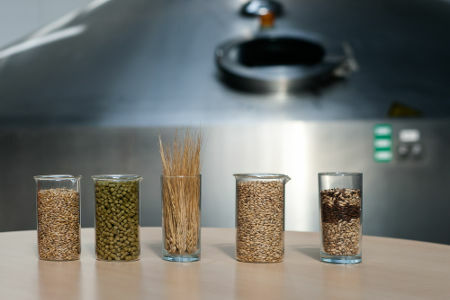The question "What is glass?" can refer to two main aspects about this material:
(1) Its chemical composition;
(2) In its state of aggregation, that is, is the glass solid or liquid?
Glass is generally produced in large-scale industries and handcrafted through a mixture of inorganic substances, which is called vitrifiable mixture. This mixture is formed bysilica or silicon dioxide (SiO2 ) (coming mostly from quartz), soda or soda (sodium carbonate - Na2CO3) andlimestone (calcium carbonate - CaCO3). These three inorganic compounds are crushed, ground into powder and mixed in the proper proportions. Furthermore, in industries, broken glass is also commonly added as part of the recycling process for this material.
This vitrifiable mixture is taken to an oven that is at a temperature of about 1500ºC. Thus, these solids fuse (go to a liquid state), forming a pasty and homogeneous mass composed of sodium and calcium silicates. This, then, is the chemical composition of common glass.
ash + limestone + sand → common glass + carbon dioxide
At2CO3 + CaCO3 + SiO2 → sodium and calcium silicates + carbon dioxide
x In2CO3 + y CaCO3 + z SiO2 → (In the2O)x . (CaCO)y . (SiO2)z + (x + y) CO2
the CO2 is eliminated in the melting furnace so that bubbles do not form on the glass. After modeling the shape of the desired object, the glass is cooled.
Do not stop now... There's more after the advertising ;)
There are also other methods of making glass, and it can also be made with other substances. Currently, for example, organic and metallic glass are well known.
Regarding the second question, which questions the physical state of the glass, we can say that it is a non-crystalline solid that presents the glass transition phenomenon. While the crystalline solid has a periodically organized microscopic structure, the solid does not crystalline, on the other hand, has a disordered structure, lacking symmetry and periodicity. translational. There are two types of non-crystalline solids, glass and amorphous solids — these do not have the glass transition phenomenon (which will be better explained below).
Glass is considered a non-crystalline solid because its cooling temperature is below the moment when its particles begin to organize themselves to carry out the crystallization process. So we say that it is a cooling below the glass transition temperature.
The glass transition temperature refers to the transition from the glassy state to the viscoelastic state. The viscoelastic state describes a behavior of a body that responds elastically to having a force applied to it. On the other hand, the vitreous state describes the behavior of a body that does not deform when a force is applied to it. Its tendency is to absorb energy and dissipate it, breaking it down.
Thus, when the molten mass is cooled to form glass, this cooling occurs at a temperature below the glass transition temperature and at a speed that does not allow atoms to organize into crystals. In this way, a body is formed that presents this glass transition. To better understand this concept, read the text "Is glass solid or liquid?”.
Thus, we can conclude thatthe glass is a non-crystalline solid that exhibits the phenomenon of glass transition and can be produced from inorganic, organic and metallic materials.
By Jennifer Fogaça
Graduated in Chemistry
Would you like to reference this text in a school or academic work? Look:
FOGAÇA, Jennifer Rocha Vargas. "What is glass?"; Brazil School. Available in: https://brasilescola.uol.com.br/quimica/o-que-vidro.htm. Accessed on June 28, 2021.

